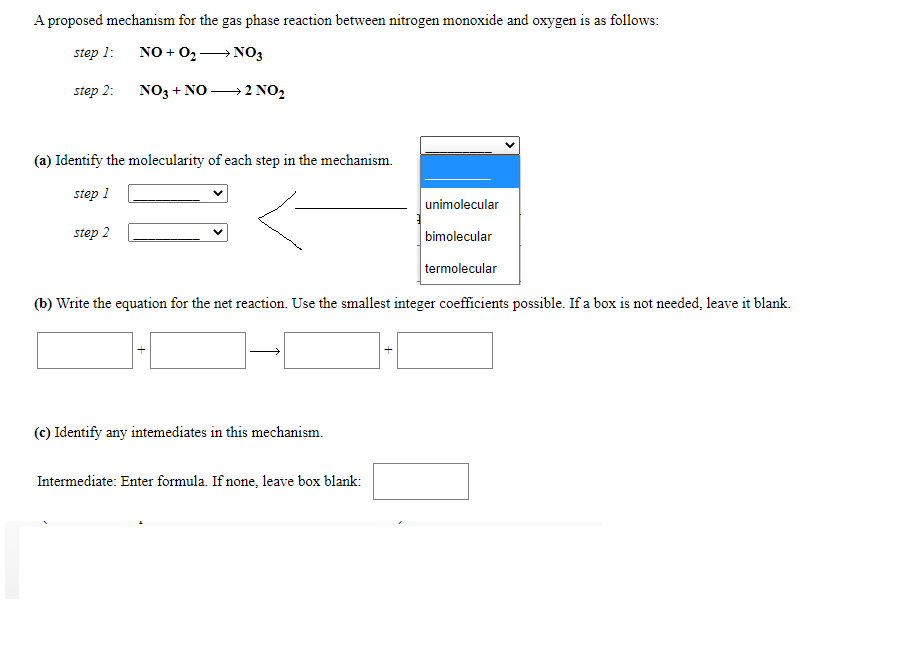A proposed mechanism for the gas phase reaction between nitrogen monoxide and oxygen is as follows: step 1: NO + 0 →NO3 step 2: NO3 + NO → 2 NO, (a) Identify the molecularity of each step in the mechanism. step unimolecular step 2 bimolecular termolecular (b) Write the equation for the net reaction. Use the smallest integer coefficients possible. If a box is not needed, leave it blank. (c) Identify any intemediates in this mechanism. Intermediate: Enter formula. If none, leave box blank:
A proposed mechanism for the gas phase reaction between nitrogen monoxide and oxygen is as follows: step 1: NO + 0 →NO3 step 2: NO3 + NO → 2 NO, (a) Identify the molecularity of each step in the mechanism. step unimolecular step 2 bimolecular termolecular (b) Write the equation for the net reaction. Use the smallest integer coefficients possible. If a box is not needed, leave it blank. (c) Identify any intemediates in this mechanism. Intermediate: Enter formula. If none, leave box blank:
Chemistry & Chemical Reactivity
10th Edition
ISBN:9781337399074
Author:John C. Kotz, Paul M. Treichel, John Townsend, David Treichel
Publisher:John C. Kotz, Paul M. Treichel, John Townsend, David Treichel
Chapter14: Chemical Kinetics: The Rates Of Chemical Reactions
Section14.3: Effect Of Concentration On Reaction Rate
Problem 14.3CYU: The initial rate ( [NO]/ t] of the reaction of nitrogen monoxide and oxygen NO(g) + 2O2(g) NO2(g)...
Related questions
Question

Transcribed Image Text:A proposed mechanism for the gas phase reaction between nitrogen monoxide and oxygen is as follows:
step 1:
NO + 02→ N03
step 2:
NO3 + NO → 2 NO2
(a) Identify the molecularity of each step in the mechanism.
step 1
unimolecular
step 2
bimolecular
termolecular
(b) Write the equation for the net reaction. Use the smallest integer coefficients possible. If a box is not needed, leave it blank.
(c) Identify any intemediates in this mechanism.
Intermediate: Enter formula. If none, leave box blank:
Expert Solution
This question has been solved!
Explore an expertly crafted, step-by-step solution for a thorough understanding of key concepts.
This is a popular solution!
Trending now
This is a popular solution!
Step by step
Solved in 3 steps

Knowledge Booster
Learn more about
Need a deep-dive on the concept behind this application? Look no further. Learn more about this topic, chemistry and related others by exploring similar questions and additional content below.Recommended textbooks for you

Chemistry & Chemical Reactivity
Chemistry
ISBN:
9781337399074
Author:
John C. Kotz, Paul M. Treichel, John Townsend, David Treichel
Publisher:
Cengage Learning

Chemistry: The Molecular Science
Chemistry
ISBN:
9781285199047
Author:
John W. Moore, Conrad L. Stanitski
Publisher:
Cengage Learning

Chemistry: Principles and Practice
Chemistry
ISBN:
9780534420123
Author:
Daniel L. Reger, Scott R. Goode, David W. Ball, Edward Mercer
Publisher:
Cengage Learning

Chemistry & Chemical Reactivity
Chemistry
ISBN:
9781337399074
Author:
John C. Kotz, Paul M. Treichel, John Townsend, David Treichel
Publisher:
Cengage Learning

Chemistry: The Molecular Science
Chemistry
ISBN:
9781285199047
Author:
John W. Moore, Conrad L. Stanitski
Publisher:
Cengage Learning

Chemistry: Principles and Practice
Chemistry
ISBN:
9780534420123
Author:
Daniel L. Reger, Scott R. Goode, David W. Ball, Edward Mercer
Publisher:
Cengage Learning

Chemistry for Engineering Students
Chemistry
ISBN:
9781337398909
Author:
Lawrence S. Brown, Tom Holme
Publisher:
Cengage Learning

Chemistry: Principles and Reactions
Chemistry
ISBN:
9781305079373
Author:
William L. Masterton, Cecile N. Hurley
Publisher:
Cengage Learning

Chemistry by OpenStax (2015-05-04)
Chemistry
ISBN:
9781938168390
Author:
Klaus Theopold, Richard H Langley, Paul Flowers, William R. Robinson, Mark Blaser
Publisher:
OpenStax